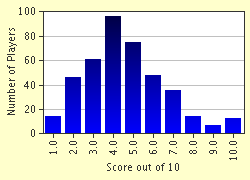Quiz Answer Key and Fun Facts
1. The name of this gas comes from Greek for "water-former."
2. He was the first scientist to define organic chemistry as the chemistry of carbon compounds.
3. In the Principles of Chemistry (1869), Russian chemist Dmitri Mendeléev published the first Periodic Table. How many elements were there in this original list?
4. What is the book "Mathematical Syntaxis" better known as?
5. "Nature and Nature's laws lay hid in night;
God said, Let ________ be! and all was light."
6. Which of the following does not fall under the "four humours", an imbalance in them believed to be the cause of diseases, in ancient times?
7. James Phipps, as a human guinea pig, assisted in the developement of the vaccination for __________ ?
8. Who was the first scientist to accurately measure the diameter of earth?
9. What would you associate H.M.S Beagle with?
10. One of them did not get the Nobel Prize, despite having made significant contributions to the discovery of DNA. Who?
Source: Author
sajish_gp
This quiz was reviewed by FunTrivia editor
crisw before going online.
Any errors found in FunTrivia content are routinely corrected through our feedback system.


